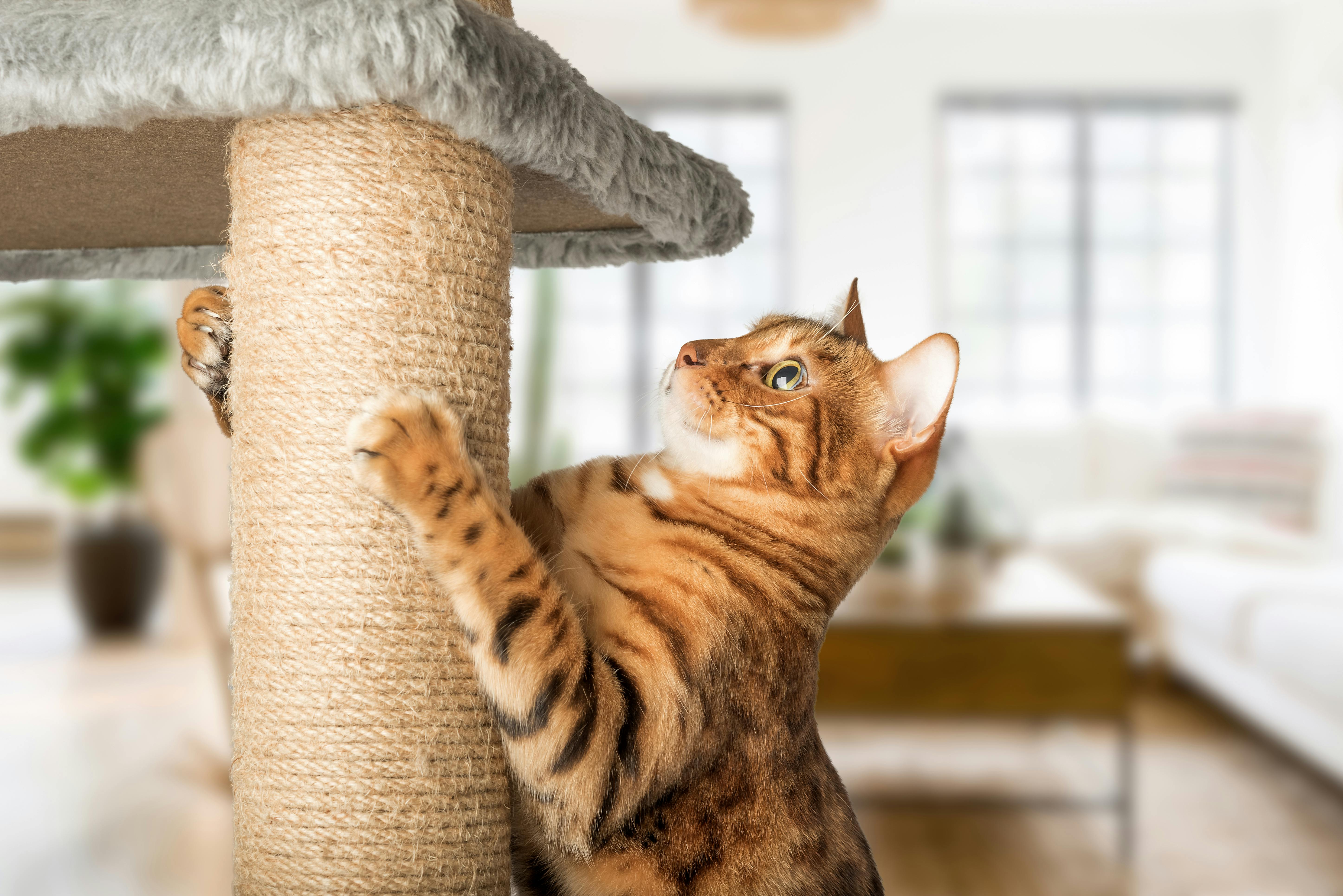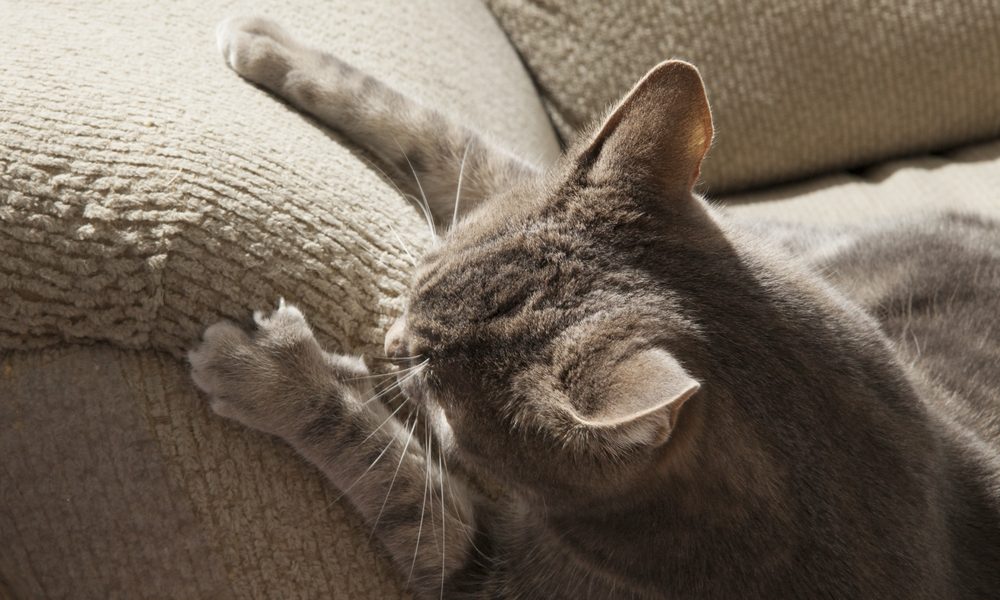It’s not ideal for cats to scratch wood, as it can damage furniture and surfaces. Scratching is a natural behavior for cats, but they should be redirected to appropriate surfaces.
Cats need to scratch for various reasons – it helps them stretch their bodies, maintain claw health, and mark their territory. Understanding this instinctual behavior can help cat owners provide suitable alternatives to wooden furniture, such as scratching posts or pads.
Ensuring these alternatives are appealing and strategically placed can prevent damage to household items. Training your cat to use these alternatives from an early age is key to protecting your wooden surfaces while also respecting your pet’s natural behaviors. Encourage use of the scratching posts by using catnip or toys, and consistently discourage scratching on wood through gentle redirection.
Scratching: A Natural Feline Instinct
Picture your cat—paws out, a determined look in their eyes, ready to take on your favorite wooden chair. Before you fret, remember: Scratching is part of who they are. This act is not just a hobby; it’s rooted in their DNA. It keeps their claws sharp, stretches their body, and helps them feel secure. Let’s explore the deeper reasons behind this ingrained behavior.
Why Cats Scratch Objects
Cats scratch for many reasons, and understanding these can help you redirect this natural behavior away from your treasured furniture:
- Maintenance: Scratching helps remove the outer nail sheaths.
- Exercise: It stretches their muscles and flexes their paws.
- Stress Relief: It’s a way to release energy and anxiety.
- Marking Territory: Scratching leaves both a visual marker and a scent.
The Role Of Scratching In Cat Communication
Scratching serves as a communication tool for felines. Here’s what they convey through those claw marks:
| Communication Aspect | Details |
|---|---|
| Visual Signals | Scratches leave a visible sign to other cats. |
| Scent Marking | Paws release pheromones that send messages to other felines. |
| Territory Claim | Marks establish ownership in a multi-cat household. |
Understanding the natural instinct of scratching allows us to empathize with our feline friends and find solutions that keep both cat and owner happy.

Credit: www.wisdompanel.com
The Draw Of Wooden Surfaces For Cats
Cats and wooden surfaces share a fascinating connection. This bond goes beyond mere aesthetics. Understanding why cats are drawn to wood can save your furniture and strengthen your bond with your feline friend.
Texture And Resistance: Why Wood Appeals
Cats love textures that mimic the wild, and wood offers a perfect blend.
- Wood has a rough texture that resembles tree bark.
- Resistance from wood is ideal for claw maintenance.
- The feeling of wood beneath their paws gives cats a sense of security.
Cats use scratching to stretch muscles and express themselves.
Wood’s texture and resistance provide that satisfying experience, making it a natural scratchpad. Furniture, while not meant for scratching, unintentionally acts as an alluring alternative.
Scratching Posts Vs. Furniture: A Cat’s Perspective
Satisfying their natural instincts is crucial for cats. They don’t differentiate between a scratching post and furniture; both serve as outlets for their needs.
| Scratching Post | Furniture |
|---|---|
| Designed for cats | Not designed for cats |
| Right texture and resistance | Similar texture, but unintended use |
| Safe for cat’s claws | Can damage claws and wood |
For a cat, the end goal is to fulfill instinctual drives such as marking territory and keeping claws sharp. They aren’t aware of the damage caused to cherished wooden items.
Understanding this behavior can empower owners to redirect scratching habits effectively. By choosing the right scratching post, you can keep your cat happy and protect your wooden fixtures.
Impacts Of Wood Scratching On Your Home
Scratching is a natural behavior for cats, often leading them to target various surfaces around the house. Wooden furniture and structures may fall victim to this instinctual activity. Understanding the consequences of wood scratching is essential for cat owners. Not only does scratching impact the aesthetic of wood, but it can also weaken the integrity of wooden items over time.
Assessing The Damage To Furniture
Scratched wood furniture can suffer from a range of surface issues. Cat owners might notice:
- Visible claw marks: Unsightly and can decrease the item’s value.
- Surface splintering: Can lead to further damage if not addressed.
- Removed finish or stain: Might require refinishing or touch-ups.
Frequent inspections can help identify the extent of the damage. This allows homeowners to plan for repairs or protective measures.
Long-term Effects On Wooden Structures
Beyond furniture, wood scratching can extend to house structures such as door frames and baseboards. These are some long-term impacts:
- Structural weakness: Continued scratching can compromise wood strength.
- Permanent scarring: Over time, deep scratches become difficult to repair.
- Costly replacements: In severe cases, whole pieces might need replacing.
Taking early action to deter your cat from scratching can save time and money. Invest in scratching posts and apply natural deterrents to keep wooden structures safe.
Strategies To Redirect Scratching Behavior
If you notice your cat has turned your favorite wooden chair into a scratching post, it’s time to redirect their behavior! Scratching is a natural and necessary cat behavior. It helps them to keep their claws sharp, mark territory, and stretch their muscles. While it’s not okay for your cat to scratch wood furniture, understanding this behavior can help you guide your cat towards more appropriate scratching outlets. Let’s dive into effective strategies to redirect your cat’s scratching habits.
Choosing The Right Scratching Posts
The key to stopping your cat from scratching wood is to provide them with better alternatives. Ensure these alternatives are visible and attractive for them. Here’s what to look for in scratching posts:
- Material: Cats prefer different textures, so offer a variety. Include sisal, carpet, and cardboard options.
- Stability: The post must be sturdy. A wobbly post can scare your cat away.
- Height: It should be tall enough for your cat to fully stretch.
- Location: Place posts near their favorite scratching spots, like that wooden chair leg.
Training Your Cat With Positive Reinforcement
Positive reinforcement makes training enjoyable for your cat. Here’s how you can train them:
- Catch them in the act: Gently move them to the scratching post when they scratch wood.
- Use treats and praise: Give them when they use the post. Make it a fun experience!
- Apply catnip: Some cats love catnip. Sprinkle it on the post to attract them.
- Repeat: Patience is key. Continue guiding and rewarding them.
With the right approach and a bit of patience, your cat’s scratching habits can be redirected to save your wooden furniture and your sanity. Offer them a variety of posts and consistently reward them for using it. They’ll soon learn where their claws are welcome!
Understanding And Addressing Destructive Scratching
Cats scratch as part of their natural behavior. Scratch marks left on wood can be frustrating. However, understanding why cats scratch is key. Addressing the behavior effectively can save your furniture and keep your pet happy.
Identifying Stress-related Scratching
Scratching can signal stress in cats. Look for patterns in their behavior. Does your cat scratch in certain situations? Or around new pets or people? Identifying these triggers can help.
- Observe your cat’s environment for potential stressors.
- Notice the frequency and location of scratching.
- Use feline pheromones or calming diffusers to ease anxiety.
Providing alternative scratching posts helps too. Position these strategicaly where your cat prefers to scratch.
When To Consult With A Veterinarian
Some scratching is normal, but excessive scratching may require a veterinarian’s attention. If your cat’s scratching seems to be out of control, it’s time to consult a professional.
- Excessive scratching could indicate skin problems.
- A sudden increase in scratching can signal stress or discomfort.
- Your vet can identify medical issues or behavioral needs.
Scheduling an appointment with a vet can lead to a happier and healthier cat.

Credit: www.sleepyhollowanimalhospital.com

Credit: www.purelypetsinsurance.co.uk
Frequently Asked Questions For Is It Okay For My Cat To Scratch Wood?
Why Do Cats Enjoy Scratching Wood Furniture?
Cats have a natural urge to scratch, which helps them to maintain their claw health and mark their territory. Wood provides a satisfying texture for cats. It mimics the natural surfaces they’d encounter in the wild.
Can I Stop My Cat From Scratching Wooden Items?
Yes, you can redirect this behavior. Offer alternative scratching posts made of materials your cat enjoys. Apply deterrents on wooden surfaces. Use positive reinforcement to encourage use of appropriate scratching areas.
Is Scratching Wood Bad For My Cat’s Claws?
No, scratching wood isn’t inherently bad for a cat’s claws. It’s a natural behavior that helps them to remove the outer nail sheaths and keep their claws sharp and healthy.
What Are The Best Alternatives To Wood For Cats To Scratch?
High-quality scratching posts wrapped in sisal fabric or rope are great alternatives. Cardboard scratchers are also popular and effective. They’re satisfying for cats to use and help protect wooden furniture.
Conclusion
Caring for your feline companion involves understanding their behaviors, like scratching wood. It’s a natural instinct for them, not just a whimsical activity. Offering designated scratch posts preserves your woodwork and keeps your cat content. Remember, a happy cat means a happy home.
Welcome their traits and find the right balance for a harmonious living space.



